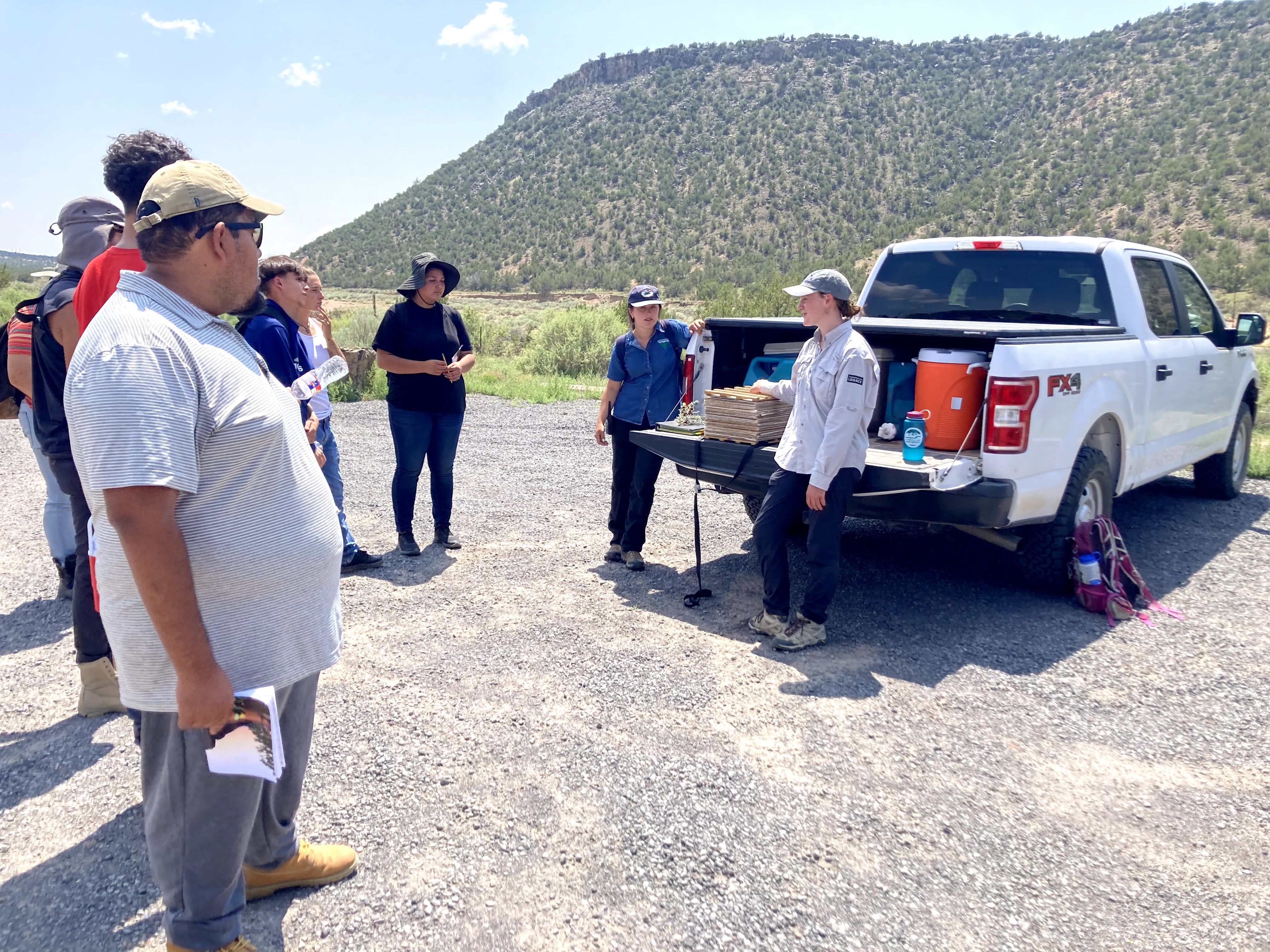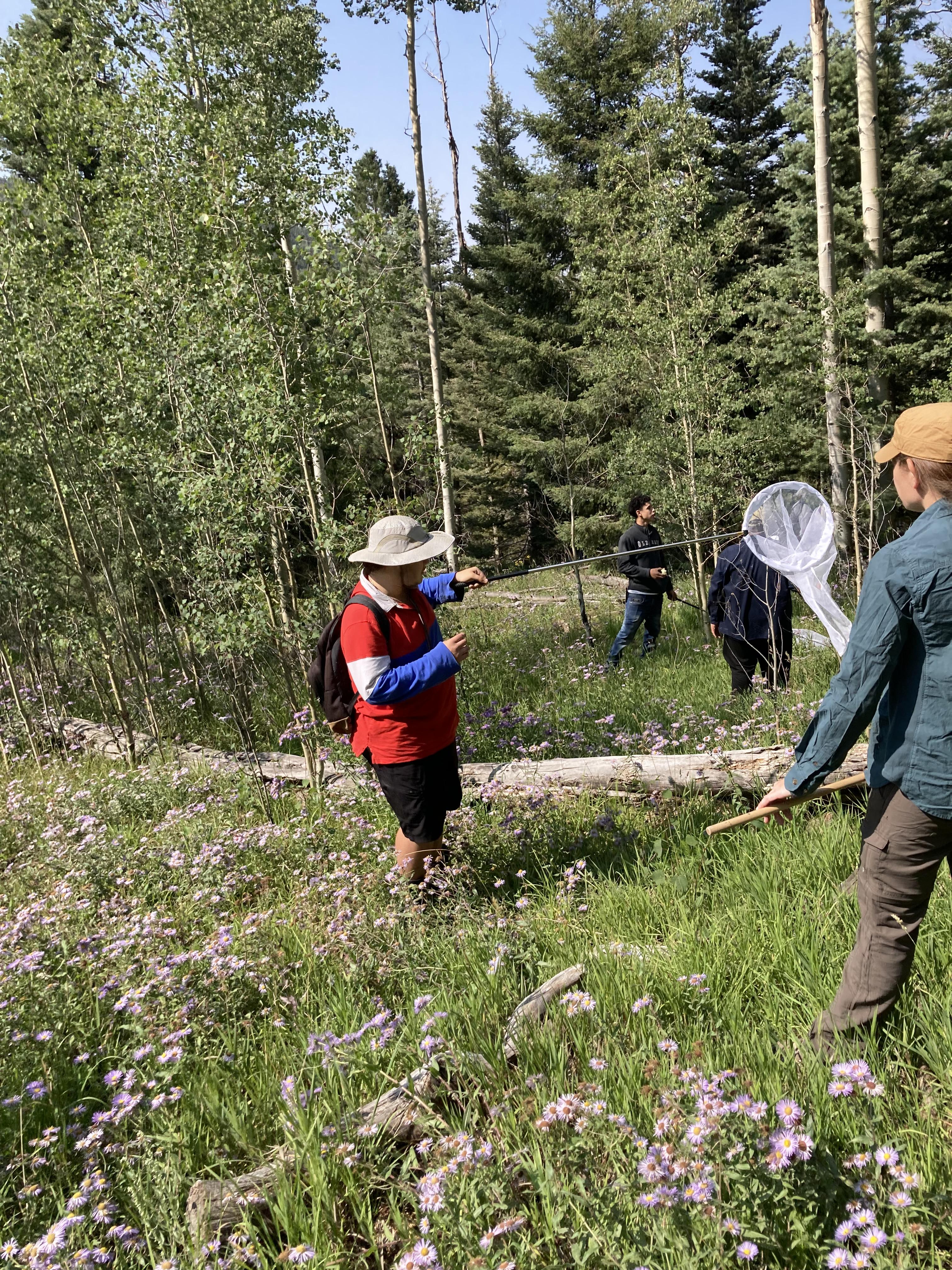
Facilitating Cultural Connections and Environmental Literacy through Southwest Forest Bound Program
By Megan Rabinowich, Ashlee Wolf, and Samuel Villareal Catanatch
September 2021
Forest Bound is a native plant immersion and conservation skill building program that examines native plant species through a botanical, ecological/environmental, and cultural lens. This summer, IAE’s Southwest Office in Santa Fe offered two Forest Bound sessions that continued collaborations with Pueblo of Pojoaque Tewa Language Department (2nd year of partnership) and with Youthworks of Santa Fe (4th year of partnership). Funding from the U.S. Forest Service Region 3 and the Walmart Foundation for 2021 and partner contributions enabled IAE SW to provide this program free of cost to participants.
Outdoor access for all!
Forest Bound seeks to increase exposure to the outdoors and ecology for all people in our local communities. It’s widely acknowledged that the demographics of outdoor professionals do not accurately reflect the general population, with a strong skew towards people of privileged backgrounds. Access to nature and conservation training play an important role in developing undiscovered interests in conservation, and yet, a disproportionate number of people from diverse backgrounds have limited access to these resources. Given that a diverse workforce is known to improve productivity (Saxena 2014), conservation organizations benefit when access to nature is more equitable. Through Forest Bound, IAE and partners work to bridge the gap between environmental education and people from demographics that have been historically excluded from the field of ecology.
Cultural Revitalization and Ecological Learning with the Pueblo of Pojoaque (Session 1)
This program interweaves lessons in botany and ecology with Tewa language exposure. Defined as “severely endangered” by the United Nations Educational, Scientific and Cultural Organization (UNESCO), Tewa is the Indigenous language of six Pueblo communities of the Rio Grande valley in Northern New Mexico. In Tewa, the Pueblo of Pojoaque is called P’osuwaegeh Owingeh, “Water Drinking Place Village.” The Director of the Tewa Language Department, Samuel Villarreal Catanatch, worked with IAE SW staff to co-develop a program focused on cultural revitalization and ecological learning, aiming to find commonality across traditional ways of knowing about the environment and Western science.
Ten Forest Bound participants, ranging from 14-68 years old, met at the Pueblo’s Poeh Cultural Center and each day in the week-long program traveled to the Santa Fe National Forest and Pueblo lands that encompass Tewa country, the unceded ancestral lands of the Tewa people.
Day 1 emphasized rooting in place and an overview of the Tewa world view presented by Louie Hena, elder of Tesuque Pueblo and renowned permaculture and traditional land management educator. This set the tone for learning about land features and ecozones, from both traditional and Western perspectives, while visiting sites within the Pueblo.
Day 2 focused on soils. Clarence Cruz, traditional Pueblo potter from Ohkay Owingeh, fluent speaker of Tewa, and University of New Mexico instructor, described how traditional Pueblo pottery is rooted in close observation and reciprocal interaction with the landscape. He showed the natural materials he gathers for pottery, including types of clay and dye plants, discussing how he locates and uses each. These tactile connections set the stage for the next mentor, Gabriella Couglin, a soil scientist with the Middle Rio Grande Valley Conservation District, who shared technical aspects of soils. Participants received Tewa language lessons, explored streams, tasted wild lemonade berries, and enjoyed learning in the Santa Fe National Forest outdoor classroom.
Day 3 was an immersion in botany including plant observations, flower dissections, and a botanical scavenger hunt in the lovely Las Conchas Trail in the Jemez Mountains. Also, Victoria Atencio from the Santo Domingo Pueblo, discussed traditional ecological knowledge (TEK) and her experience learning the stories and traditional uses of plants. Participants reflected on and exchanged stories about what traditional ecological knowledge had been passed onto them.
Day 4 illustrated plants in agriculture. At the Tesuque Farm in Tesuque Pueblo students saw first hand examples of sustainable building practices, seed storage, and farm operations and hand cleaned seeds. Emigdio Ballon, Quechua agricultural expert, manages the farm along with Tewa people from the surrounding communities.
Day 5 focused on restoration. Shantini Ramakrishna, instructor at New Mexico Highlands University, demonstrated the function and methods of building one-rock dam structures in a Pueblo of Pojoaque drainage to slow erosion and increase sediment deposition. We wrapped up the program with a sakawe (blue corn porridge) cooking demonstration by Cris Velarde, a cota tea refreshment, and a game of jeopardy highlighting all that was learned and experienced during the week. This session was a special opportunity to engage in a reciprocal relationship with our surrounding environment.
Cultivating Environmental Literacy on the Santa Fe National Forest with Youthworks (Session 2)
Youthworks’ mission fits ideally with IAE’s Forest Bound goal to increase exposure and access to the outdoors and natural sciences to underserved youth: Founded in 2001, Santa Fe Youthworks seeks to connect “at-risk” and disadvantaged youth to communities through education, employment training, and job placement.
In late August at the height of the monsoon season, we kicked off the Youthworks Forest Bound session at the Little Tesuque picnic area in the Santa Fe National Forest. Students got an introduction to botany, starting with a “plant sit” in which each participant spent quality time with a plant, drawing it, and describing characteristics of the plant and ending with learning technical botany terms, including plant morphology and classification systems. It was inspiring to see the students’ beautiful and accurate plant drawings, highlighting how carefully they observed their plants. The day culminated in a scavenger hunt where students tried to find plants with certain characteristics, like palmate leaves or an umbel inflorescence.
Throughout the rest of the week, IAE staff and mentors delivered lessons in ecology and conservation skill building. IAE’s Kristen Birdshire led a pollinator workshop where students netted insects flying around a montane meadow, observed differences among pollinators, and learned plant-pollinator relationships/pollinator syndromes. Seed crew leader for Conservation Corps of New Mexico, Elizabeth Buhr, trained students on how to make native seed collections in Diablo Canyon. Gazing up at the Diablo Canyon formations further helped students envision how millions of years of water erosion shaped New Mexico landscapes. Back at the IAE seed studio, students participated in the next important step of cleaning seeds. And at the end of the week they participated in a restoration project at the Leonora Curtin Wetland Preserve by seeding degraded areas and pulling weeds. These hands-on experiences solidified their understanding of the path that seeds take from collection to cleaning to restoration.
The plant family snack break was a highlight for all. Eating snacks derived from plant families is a fun way to engage other senses and capture interest in plant traits and uses. With grocery stores in the modern age, and consumers becoming increasingly disconnected from the natural origins of food, many people lack understanding of where our food comes from and what is actually on our plates. For example, after enjoying a rose family snack of raspberries and strawberries, one student excitedly made the connection that the familiar raspberry--an “aggregate” fruit--could be planted and grow many plants from one raspberry. And during the cactus family snack, it was discovered that many students who had lived in Santa Fe their entire lives had not known that the prickly pear pads and fruits of the cactus family were edible.
It is clear that despite free access to many public lands near Santa Fe, spending time in natural areas remains somewhat of a luxury. These beautiful areas need to be for everyone, and immersion programs like Forest Bound help make the connection that everyone has a place in the forest. Watching students grow and become more engaged with the material throughout the week was extremely rewarding for the program coordinators - from being unfamiliar with the terms “ecology” and “botanist” to being able to use a dichotomous key to identify plants! The future for Forest Bound is bright, and even brighter knowing it is lighting the flame for future scientists and appreciators of the natural world.
Acknowledgments
We would like to thank the U.S. Forest Service Region 3 and the Walmart Foundation for funding Forest Bound. These rich programs would not have been possible without the support and contributions from our partners at Youthworks and the Pueblo of Pojoaque Tewa Language Department and professional mentors who volunteered their time.
Restoration
Research
Education
Get Involved
Contact
Main Office:
4950 SW Hout Street
Corvallis, OR 97333-9598
541-753-3099
[email protected]
Southwest Office:
1202 Parkway Dr. Suite B
Santa Fe, NM 87507
(505) 490-4910
[email protected]
© 2024 Institute for Applied Ecology | Privacy Policy



